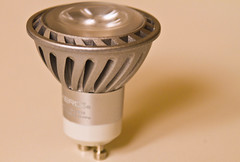I attended the Smart Grids Europe Conference 2010 in Amsterdam last week. One of the people displaying there was Thomas Joergensen of TrickleStar.
TrickleStar are not a Smart Grid company per se, what they offer instead are devices to cut down on energy consumption in the home. As such, their clients are utility companies who want to help their customers cut their consumption as well as companies and individual homeowners interested in reducing their energy bills.
What kind of devices do they have? As can be seen from the video, the two main devices they were showcasing at the conference stand were ones which cut standby power to your peripherals (monitor, printer, ext hd, etc.) when you shut off your computer. Given I have already published some videos about the amount of electricity drawn by devices in standby mode (phantom load), I was delighted to see these great solutions.
I asked Thomas if there was any metering functionality in the devices and he said that was something they were working on.
Related articles by Zemanta
- TrickleStar Adds New Energy-Saver Tool To Line-Up – The TrickleStrip (treehugger.com)
- Intel Making Moves Into Smart Grid Technology (treehugger.com)
- Google Asks Obama to Support Home Energy App Platform (readwriteweb.com)




